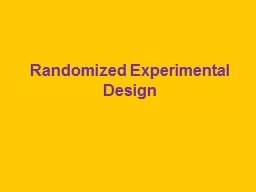

What is an Experiment Campbell amp Stanley stressed random assignment to experimental treatments I stress manipulation of the independent variable QuasiExperiments CampSs term for research where ID: 652945
Download Presentation The PPT/PDF document "Randomized Experimental Design" is the property of its rightful owner. Permission is granted to download and print the materials on this web site for personal, non-commercial use only, and to display it on your personal computer provided you do not modify the materials and that you retain all copyright notices contained in the materials. By downloading content from our website, you accept the terms of this agreement.
Slide1
Randomized Experimental DesignSlide2
What is an Experiment?
Campbell & Stanley stressed random assignment to experimental treatments.
I stress manipulation of the independent variable.
Quasi-Experiments: C&S’s term for research where
there is a manipulated IV
but not random assignment to groupsSlide3
Random Selection
Refers to the selection of data points from a population into a random sample.
This selection procedure will be random if each possible sample of size
N
is equally likely to be sampled.
Random samples should be representative of the population.
Our inferential statistics assume random sampling.Slide4
Note. The tabled values are probabilities.
Y is random, X is not.
In Y, each time a single score is sampled, all scores in the population are equally likely to be sampled.Slide5
Random Assignment
Refers to the assignment of subjects to treatment conditions.
Allows us to consider the
populations
(subjects who will get special treatment and those who will not) as equivalent prior to treatment.
The
samples
will likely differ a little.Slide6
Two Basic Randomized Designs
Randomized Pretest-Posttest Control Group Design
R O X O
R O O
Randomized Posttest Only Control Group Design
R X O
R OSlide7
Noise Reducing Designs
These designs reduce noise (error variance) and thus increase power.Slide8
Randomized Blocks Designs
Matched pairs,
randomized
blocks.
Repeated measures or within-subjects.
Variance due to the blocking variable is removed from error variance.Slide9
Analysis of Covariance
Change
a
noise-producing extraneous variable into a covariate that is included in the statistical model.
Must be able to measure the covariate.
Variance due to covariate is removed from the error variance.
Can have more than one covariate.Slide10
Factorial ANOVA
Convert a categorical extraneous variable to an ANOVA factor.
Variance due to that factor will be removed from the error term.
2 x 2 Factorial Design
R X
11
O
R X
12
O
R X
21
O
R X
22
OSlide11
Other Randomized Designs
Solomon Four Group Design
Controls threats to internal and external validity as well as the posttest only control group design.
But has greater power.
And greater cost
Need more data
More complex analysis
R O X O
R O O
R X O
R OSlide12
Solomon Four Group Design
ANOVA
Arrange all four groups’ posttest scores into a 2 x 2 ANOVA.
Pretested or Not x
Experimental Treatment or Not.
Significant Interaction – Testing x Treatment threat to External Validity
Main effect of pretesting.
Main effect of treatmentSlide13
Treatment effect but no testing or Testing x Treatment interaction
Pretest means in parenthesesSlide14
Treatment and testing effects but no Testing x Treatment interactionSlide15
Treatment and testing effects and a Testing x Treatment interactionSlide16
Solomon Four Group Design
Pretest-Posttest Analysis
To gain power, analyze the pretest-posttest portion of the design with
ANCOV, using pretest scores as covariate
Mixed factorial ANOVA
planned comparisons using
t
control versus treatment change scores (independent
t)pre versus post for control group (correlated t)pre versus post for treatment group (correlated t)Slide17
Randomized Switching- Replications Design
R O X O O
R O O X O
Attempt to control social threats to internal validity.
Both groups get the special effect, one early, one later.
May still be social effects with respect to who gets it first.Slide18
Switching Replications
Temporary Treatment Effect
Group 1 got the treatment first.
Treatment is anxiety-reducing drug
DV = measure of anxiety reported by patientSlide19
Switching Replications
Persistent Treatment Effect
Treatment is psychotherapy
DV = measure of anxiety reported by patient
A third posttest could show the effect does not last indefinitely.Slide20
Switching Replications
Continuing Treatment Effect
Treatment = cognitive psychotherapy
Anxiety continues to decline beyond the first post-treatment observation, as patients get better at employing the cognitive technique.